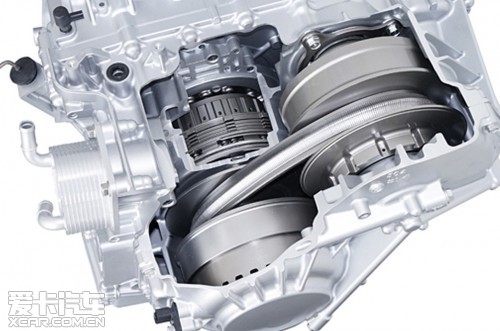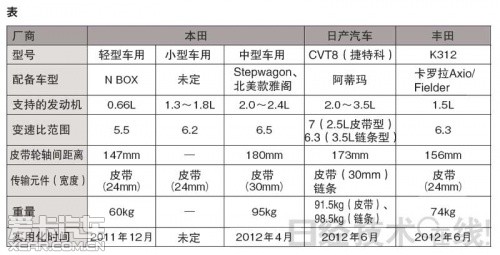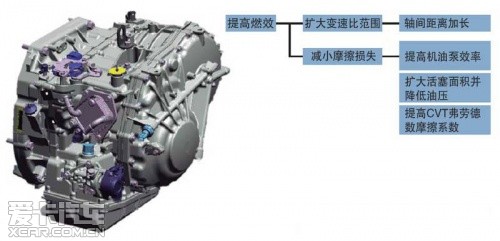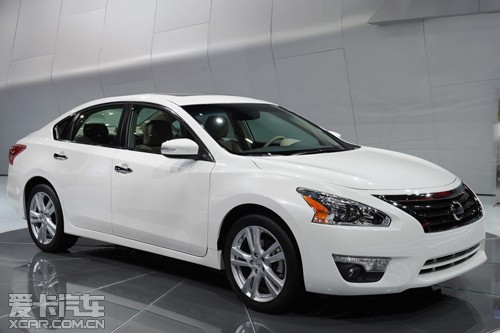Recommendation: According to Nikkei Automotive Technology, several major Japanese automakers are currently equipping a new generation of CVT gearboxes to new models. This situation has appeared in the North American market, but different from the past, its strategy will focus on the global market and replace and eliminate the current AT gearbox on a large scale. In China, Honda and other manufacturers have also made it clear that the new models will be equipped with CVT. I recommend this article to everyone to understand the future layout of these enterprises in the main products.
Speaking of automatic transmission, DCT(Dual Clutch Transmission) is adopted in Europe, AT (automatic transmission) is adopted in the United States, and CVT (continuously variable transmission) is adopted in Japan. Up to now, it is common sense to adapt to local conditions everywhere. However, Nissan adopted a brand-new CVT for the North American model Altima, and Honda also decided to equip the North American model Accord with CVT, which broke this common sense. This paper discusses the latest CVT technology that is being developed to Japan, North America and even the whole world.
Honda partially improved "Stepwagon" in April 2012, which increased the fuel efficiency of JC08 mode from 13.4km/L to 15.0 km/L.. In the overall fuel efficiency improvement of 12%, except the effect produced by idle stop mechanism, the remaining 5% is attributed to the improved and updated CVT (Figure 1).

[Honda Stepwagon]
In fact, the CVT is not only equipped on Stepwagon, but a new "Accord" to be listed in North America in the autumn of 2012, and then a strategic component to be launched around the world. Previously, the North American Accord has been using a 5-speed automatic transmission (5AT), and the goal of the new CVT is to improve the fuel efficiency of the urban high-speed mixed mode by 10%.

[CVT for medium-sized vehicles developed by Honda]
Support 2.0~2.4L engines. The fuel efficiency is 5% higher than the original CVT and 10% higher than the 5-speed automatic transmission. (b) "Stepwagon" equipped with the CVT for the first time.
Among the medium-sized cars in North America, the new "Atima" launched by Nissan in June adopts a new CVT, and now the car has the current top fuel efficiency — — The urban area is 27mpg(11.5/L) and the expressway is 38mpg(16.2km/L). Honda also chose CVT to compete with it.
In the past, CVT had excellent fuel efficiency at low speed, but it was not good at high speed. Moreover, there are also opinions that the rapid acceleration performance is not good. However, Honda related people said, "From the example of Atima, we can know that CVT has sufficient commodity power in the United States."
Developing three new CVT in one breath
Of course, the new CVT has improved both acceleration performance and fuel efficiency. The range of speed ratio has been increased from 5.5 to 6.5. It is much larger than 5AT or so. By reducing the reduction ratio of Low Gear, the acceleration performance is improved, and at the same time, by increasing the reduction ratio of high gear, the engine speed during stable driving is reduced.
In addition to CVT for medium-sized vehicles, Honda is constantly updating its products for light cars and small cars. It was originally launched as a light vehicle product, which has been applied to the "N BOX" launched in December 2011. In addition, it is planned to update CVT used for small cars such as Fit and replace AT with it (table below).

CVT for medium-sized vehicles supports 2.0~2.4L displacement engines, and its torque capacity is above 240 N m.. The CVT is different from the previous one, and it is envisaged to be applied globally. It also includes areas with long driving distance and severe use environment. Therefore, the new CVT has been redesigned with emphasis on reliability and durability (below).

[The range of transmission ratio is expanded to 6.5]
At the same time, the fuel efficiency and durability are improved and promoted to the whole world.
The layout of the basic axis has not changed. First of all, after the input from the crankshaft, there is a torque converter, a planetary gear mechanism that can switch forward and backward, a primary pulley, a secondary pulley, a countershaft and a final reducer for transmission, which belongs to a more orthodox layout.
What has changed is that the distance between the shafts of the pulley is expanded from the original 170mm to 180 mm. This is slightly longer than the new Jetco "CVT8" equipped by Nissan for Atima. When the distance between shafts is widened, the range of speed change ratio can be easily expanded and the transmission radius will be increased, so the efficiency will be improved. In addition, the diameter of the piston required for the pulley to clamp the belt can be enlarged.

[Nissan Altima]
Because the force pushing the pulley depends on the piston area, oil pressure and friction coefficient of engine oil, the oil pressure can be reduced by expanding the piston area by 20% and increasing the Froude number friction coefficient of CVT. Low oil pressure can reduce the load of oil pump.
Moreover, in order to improve the efficiency of the oil pump, a chain-driven Vane Pump with two oil inlets and two oil outlets is also adopted. At low speed, the engine oil sprayed from one of the oil outlets can be returned to the input end, and the driving loss can be reduced by semi-spraying. Although this method has been used before, this time it has expanded the scope of semi-spraying.
It also supports four-wheel drive models.
In order to improve the reliability, a grinding process is also implemented to prevent the abrasion between the high-strength belt and the pulley. Because the car travels a longer distance overseas, the grinding process named Lapping is added to the original belt pulley processing while improving the durability of the belt. Therefore, the abrasion of the pulley surface can be reduced.

[Stepwagon’s four-wheel drive also uses CVT gearbox]
Stepwagon’s four-wheel drive also uses CVT. In the past, even though CVT was used for two-wheel drive, AT was mostly used for four-wheel drive. The reason is that in order to prevent the locking of the driving wheel, it is necessary to control to adjust the transmission ratio instantly according to the reaction force applied to the gearbox, but it is difficult to ensure the reliability of the four-wheel drive vehicle with large reaction force.
However, this time, the control performance of the engine was improved, and the burden of CVT was successfully reduced by adjusting the forward and backward switching clutch of the gearbox during locking. In the past, the forward and backward clutches and the lock-up clutch shared a hydraulic valve, and it was necessary to switch circuits. But this time, a linear solenoid was added and changed into independent control mechanisms.
In the miniaturization and lightweight of the gearbox, the gasket divided into four pieces sandwiched between the housings was changed to metal, thus improving the rigidity when connecting the housings. Moreover, measures such as reducing the size of the valve body of the control system and reducing the thickness of the pulley have been added, so that although the torque capacity has been improved to some extent, the weight is still 95kg.
To be continued … …
关于作者